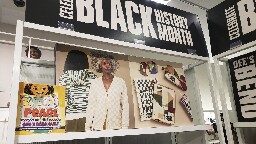They made one-of-a-kind quilts that captured the public's imagination. Then Target came along



Over the past two decades, Gee’s Bend quilts have captured the public’s imagination with their kaleidoscopic colors and their daring geometric patterns. The groundbreaking art practice was cultivated by direct descendants of slaves in rural Alabama who have faced oppression, geographic isolation and intense material constraints.
As of this year, their improvisational art has also come to embody a very modern question: What happens when distinctive cultural tradition collides with corporate America?
Enter Target. The multinational retailer launched a limited-edition collection based on the quilters’ designs for Black History Month this year. Consumer appetites proved to be high as many stores around the country sold out of the checkered sweaters, water bottles and faux-quilted blankets.
Unlike the pay structure of the Freedom Quilting Bee of the 1960s — an artist-run collective that disbursed payment equitably to Gee’s Bend quilters, who were salaried and could set up Social Security benefits — one-off partnerships with companies like Target benefit only a small number of people, in this case five women from two families.
You lay all of the blame on Target and act like they stole the designs and that they weren't licensed them. Target didn't pillage someone's cultural heritage, someone sold their cultural heritage to a corporation. If they valued it so much, why would they do that? You cant complain that your heritage was stolen when you willingly sold it away. Your beef is with the designer, NOT Target.
Because they did steal the designs. They gave the quilters a pittance and made a fortune off of it without giving them a share. I would have considered that theft if it were my designs.
From the article:
Furthermore:
And why did those quilters accept that fee? Because they were living in poverty.
They took advantage of poor people by offering them a lump sum and then reaped the benefits exponentially more.
And to rub salt in the wounds:
They didn't even give these people recognition after one month. Despite this being a very important part of their local culture, which went back to when they were slaves.
The whole thing stinks and you should not be defending it.
Exactly, it’s easy to have principles with a full stomach
Maybe I scanned that article too quickly. Did they say how much money the 5 artists agreed upon for the collab, or how much profit Target made from it?
No. Do you think what those artists got paid came even close to the profits Target made on the designs of theirs that Target both altered and removed the history from?
I’m a professional product designer and I have worked with Target. Target has been one of the better companies I have worked with. That said, I’d have to see the numbers to make a call on whether or not I thought they got a fair shake in the licensing deal that they agreed to.
As for the history element, I’m on the fence. On one hand, the cheaper manufacturing and blander colors are not representative of the original work. On the other hand, they take inspiration from the original work, are getting more people to look into the quilting movement, and they will probably generate increased demand for the originals.
This reminds me a lot of when a big studio pushes a musical act that is a more commercial version of something that’s in an indie scene. On one hand, the people from the indie scene get super pissed at the blander, more commercial, act. On the other hand, more people usually start to dig into the music scene that inspired the commercial act. And indie acts from the original scene finally start making a buck and getting noticed more.
This is far more egregious than that in my opinion, since this is an art form directly linked to slavery. This is an art started by their enslaved ancestors, and which they continue in their memories.
In the music biz, people get mad at the broke artist who decides to make a buck from licensing their shit to a corporation. In the quilting biz, people get mad at the corporation for approaching the artist in the first place.